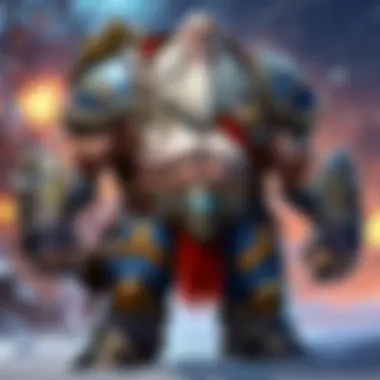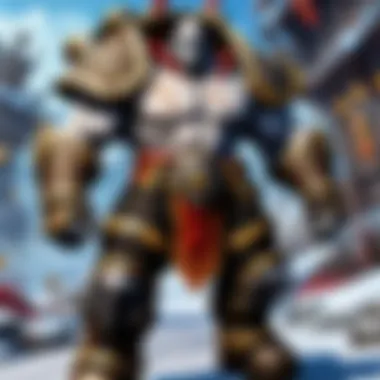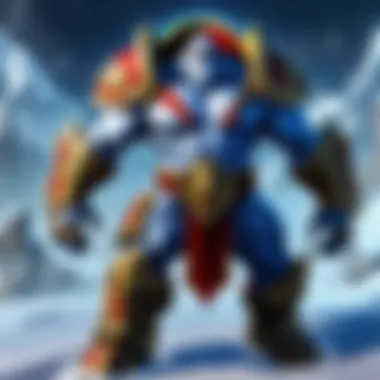Exploring the Dynamics of Gaming Loot in Blizzard Titles


Preface to Gaming Loot
Gaming loot, a central element in the player experience, encapsulates the excitement and surprise that elevate the sheer enjoyment of gaming. Especially in titles developed by Blizzard, loot holds significant weight, contributing to both short-term engagement and long-term investment in the game. As the gaming world evolves, understanding the dynamics of loot becomes critical to grasping the broader mechanics of gameplay.
Defining Gaming Loot
At its core, gaming loot refers to items, equipment, or resources that players acquire throughout their gaming journey. This concept extends beyond mere physical items; it embodies a blend of virtual rewards that can enhance gameplay, alter player strategies, and facilitate individual expression within the game's universe.
- Equipment such as weapons, armor, and other gear can crucially influence a character's capabilities.
- Resources, which can represent consumables or crafting materials, allow for progression and achievement.
- Cosmetic items such as skins or visual modifications enhance personalization and aesthetic appeal.
Understanding loot enables players to navigate their chosen games more strategically, maximizing the intrinsic benefits associated with diverse in-game treasures.
The Evolution of Loot in Gaming
The development of loot systems reflects the historical shifts in gaming investment and engagement approaches. Originally, loot was predominantly linear and predictable, often providing minimal variability in rewards. As game designs evolved, so too did the intricacies of loot generation and distribution. Modern loot systems have shifted toward incorporating chance-based elements, enhancing the rollercoaster of acquisition experiences. Players may now encounter:
- Randomized drops, which can yield unexpected rewards, injecting thrill.
- Far-reaching frameworks, such as seasonal events, encouraging sustained gameplay and community involvement.
Works by Blizzard, such as World of Warcraft and Overwatch, illuminate these shifts in loot strategies well. By continuously refreshing their loot mechanisms, Blizzard's titles remain enticing and competitive, drawing both new and returning players to explore ever-changing landscapes.
From early concepts of set-in-stone rewards to current systems teeming with unpredictability, gaming loot has transformed, resonating significantly within fandoms while facilitating game longevity and player satisfaction.
Types of Loot in Blizzard Games
Understanding the types of loot in Blizzard games is vital for comprehending how these elements influence player interactions and the overall gaming experience. In varied realms like World of Warcraft and Overwatch, loot serves to motivate, reward, and engage players in distinctive ways. By exploring these categories, we shed light on how loot drives player behaviors and satisfaction, ultimately affecting game longevity and joy.
Loot Mechanics Overview
Loot mechanics in Blizzard titles encapsulate the rules governing how rewards are distributed. Different games employ varied systems, encompassing both random drops and fixed rewards. These mechanisms dictate player engagement. For instance, Diablo III uses random loot generation, creating excitement surrounding each find. This unpredictability delivers a sense of achievement while making players pursue their loot goals more energetically. Players often evaluate their performance based on loot outcomes, establishing progression ties between success in gameplay and fair reward distribution.
Types of Loot: Equipment and Resources
In Blizzard games, not all loot offers the same impact. Two main types stand out: equipment and resources.
Equipment serves to enhance player capabilities, providing powerful gear that can drastically change gameplay experience. In World of Warcraft, acquiring epic items through raids elevates players’ skill levels, promoting group activities and community bonding. Players share spoilers of the hunt for these impactful rewards.
Meanwhile, resources such as crafting materials play their part as well. Even mundane items can create urgency. Materials found or looted can translate into crafting potent gear or elixirs. This driving force behind resource management stimulates a different kind of gameplay, steering players to gather efficiently.
Cosmetic Loot: Skins and Customization Options
Another significant category of loot in Blizzard titles comprises cosmetic loot. This mostly involves player customization features such as skins, emotes, and other aesthetic elements. In games like Overwatch, featuring vivid character skins motivates extensive player investment. The significance lies in individual expression, letting players personalize their heroes uniquely.
Cosmetic loot can also heighten inclusivity. Players relate to a diverse representation among character skins, thereby increasing attachment to the game. Notably, while cosmetic options do not enhance gameplay power, they foster player identity and community belonging, firmly rooting emotional investment within the gaming sphere.


“Customization transforms gameplay. Players attach personal narratives to characters through skins, affecting team identity and cooperation.”
This connection demonstrates how loot surpasses mere utility in the gaming context. Identifying and understanding these different loots empowers players with knowledge, greatly enhancing their concerns and strategies within Blizzard’s vast universe. Overall, appreciating the dynamic mechanics fosters a more engaging and meaningful gaming experience.
Rewards Systems in Blizzard Titles
Rewards systems play a crucial role in Blizzard games, influencing how players engage with content and derive satisfaction from their efforts. These systems are vital not just for personal achievement, but also for fostering player community dynamics. By examining the core elements of reward mechanics, we enhance our understanding of Blizzard’s designs. This aspect examines player habits and how loot distribution methods impact overall gameplay experiences.
Randomized Loot vs.
Guaranteed Drops
In many Blizzard games, loot emerges in two primary forms: randomized and guaranteed drops. Each path offers players a distinct experience and sets various expectations.
Randomized loot generates an atmosphere of uncertainty. Players might anticipate loot drops from defeated enemies or completed quests, but the outcome is unpredictable. For example, in World of Warcraft, a player might defeat a high-level boss but only receive common items or none at all. This randomness can create excitement because it feeds into the hope of obtaining powerful equipment or exclusive items.
On the other hand, guaranteed drops provide a sense of assurance. When players know that certain tasks or events yield a specific reward, it directs their engagement. With games like Diablo III, players encounter known conditions under which items are dropped after clearing dungeons or competing in seasonal events.
In summary, both systems have their benefits. Randomized loot may enhance thrill, while guaranteed drops cultivate determination toward certain achievements, thus ingraining deeper play patterns.
The Role of Raids and Dungeons
Raids and dungeons serve as cornerstone experiences in Blizzard games, forming essential elements of player progression through their complex loot systems. Within these challenging environments, teams collaborate to locate, defeat, and reap rewards.
One significant benefit of raids is their capacity to solidify community bonds. Players join forces to challenge tough opponents, which encourages teamwork and strategic alliances. Successful raids often lead to player accolades along with highly sought-after rewards, augmenting the gaming experience significantly. In World of Warcraft, for instance, legendary items may only be obtained through raid participation, prompting extensive preparation.
Dungeons present another dimension. They often offer more controllable encounters than raids, making them accessible to a wider range of players. Dungeons can be completed repeatedly for chances to acquire various loot, satisfying both casual and dedicated players. This balance is crucial, as it allows less experienced players a pathway to earn better gear without the extensive commitment raids demand.
Loot's Impact on Gameplay Experience
The dynamics of loot systems in Blizzard games play a critical role in shaping the overall gameplay experience. It's not merely a matter of accumulating in-game items; rather, the mechanisms behind loot acquisition and rewards serve to deepen player enjoyment and immersion. This section will explore specific elements of loot's impact, its benefits, and various considerations.
Enhancing Player Engagement
Player engagement is vital for the success of any title within the Blizzard portfolio. The allure of loot encourages players to invest time and effort in the game. By introducing various types of loot, including unpredictable drops and valuable rewards gathered through exploration, Blizzard creates an incentive for players to continue playing. The thrill of uncovering a rare piece of equipment or a coveted skin enhances enjoyment, shifting focus from other gameplay challenges.
Key factors that contribute to player engagement through loot systems include:
- Variety of Rewards: Players are drawn in by the diversity, as equipment, resources, and cosmetics each add competitive dimensions to engagement.
- Social Interaction: Players often form alliances or partnerships in search of elusive loot. Shared goals can ignite friendships within the gaming community, fostering teamwork.
- Sense of Accomplishment: Upgrading characters or acquiring coveted items offers a necessary satisfaction that reinforces gameplay immersion.
Overall, loot enhances the world-building aspects of Blizzard titles and ensures each game session feels unique and fulfilling.
The Psychological Effects of Loot Acquisition


The psychological ramifications of looting in gaming environments are particularly intriguing. The anticipation that comes with opening loot boxes or accumulating experience points leading to item rewards can trigger dopamine release. This chemical change resonates deeply with the player, fueling future play sessions.
A few psychological aspects worth consideration include:
- Reward Prediction: Players develop expectations about what they might earn in different circumstances. Failing to receive expected rewards can lead to what psycholigists suggest as "loot disappointment."
- Crafting a Narrative: Loot acquisition often aligns creates personal stories for players, where each item carries a memory. This effort become more than habitual; it's deeply engrained in personal timelines.
- Spend Money for Value: Some players may invest more time or finances into acquiring rare items. This can develop a form of loyalty; however, it also raises concerns over in-game purchases and spending addictions.
"The allure of loot often keeps players hooked, each item acquired carries a emotional significance beyond its in-game purpose."
The combination of these psychological elements propels gamers through immersive, narrative-rich experiences within the thoughtfully positioned landscapes of Blizzard titles. Loot's role evolves from an ordinary in-game mechanism to a complex brain engagement strategy.
The Economic Aspect of Loot
The economic aspects of loot in Blizzard titles hold a critical place in discussing the overall gaming experience. Understanding how loot affects in-game economy and player behavior can highlight numerous benefits and considerations. Players often engage with loot not merely for combat advantages but also as methods for generating in-game wealth and status. This serves to enhance player commitment and experiences longer. Moreover, scrutinizing economic structures breaks down the complexity of reward distribution across various gaming environments.
In-Game Economy and Marketplaces
Blizzard has created diverse in-game economies within different titles. Players often engage in activities like trading or crafting, enhancing the overall ecosystem. Marketplaces act as platforms where players can exchange various loot items ranging from simple gear to sought-after high-tier weapons. This player-driven economy can serve many functions:
- Stimulating Competition: Players often compete for rare collectibles.
- Creating Community Dynamics: Players join together, gathering loot for shared goals or trading it.
- Driving Business Models: The existence of a robust marketplace facilitates the financial health of the game.
This economy adjusts many aspects of gameplay. Supply and demand play a significant role here. In most cases, rare items become coveted treasures, seeking players willing to exchange valuable in-game resources or currency. The development team also keeps a watchful eye on this economy, making adjustments to maintain balance and enhance player interactions. As these dynamics evolve, they exemplify the fluid nature of economic strategies that players adopt for maximizing their competitive edge.
Real Money Transactions and Monetization
The concept of real money transactions raises particular concerns and insights. Blizzard incorporates real money monetization strategies, particularly evident in titles like World of Warcraft or Overwatch. These transactions often include loot boxes or premium currencies. Although these methods present financial opportunities for the company, they also raise ethical dilemmas regarding fairness and engagement.
Discussion Points:
- Player Engagement: While offering paths to acquire loot through payment may heighten churn strategies, it can also deter casual players unable or unwilling to spend additional currency.
- Potential Abuse: Intensive monetization strategies have triggered discussions about gambling-like qualities, particularly concerning younger audiences reacting to this form of purchase.
The shift toward these strategies prompts broader questions surrounding profitability and players' willingness to engage financially beyond the initial purchase of the game.
Ethical Considerations in Loot Systems
Understanding the ethical considerations in loot systems is crucial for players and developers alike. The gaming industry, particularly companies like Blizzard, often implements complex loot systems that can influence player behavior, satisfaction, and revenues. The ethical design builds trust with the community, while addressing concerns surrounding fairness, transparency, and the potential for exploitative practices.
Loot Boxes and Gambling Implications
The use of loot boxes in games has drawn significant attention for their resemblance to gambling. Loot boxes function as randomized rewards, allowing users to spend in-game currency or real money to obtain a mystery item. Critics argue that this mechanic can predispose players to gambling behaviors. Young players, who are especially vulnerable, may be drawn into spending without understanding the odds against them.
"Research has shown a correlation between loot boxes and gambling disorders, prompting regulatory scrutiny across various regions."
Game designers face challenges in establishing what constitutes ethical loot box mechanics. Clear communication regarding the odds of receiving specific items can help mitigate this issue. Countries like Belgium and the Netherlands have taken steps to applaud or penalize such practices as gambling. This regulatory environment continues to evolve and places an obligation on developers to stay informed and responsive.


Balancing Fairness and Profitability
Balancing fairness and profitability involves a careful consideration of a gaming company's long-term reputation against short-term monetization goals. Effective loot systems should promote player enjoyment without feeling coercive or punishing. It is important for developers to embrace strategies that bring value to their players.
Some methods to consider include:
- Offering fair paths for obtaining items without additional payments, enhancing a player's skill or in-game dedication.
- Reducing reliance on randomized rewards in favor of guaranteed or user-controlled options.
- Implementing visibly diverse options for item customization at various price points.
Transparency about how monetization impacts gameplay encourages a more resilient player-community relationship. Striking this balance not only impacts consumer trust, but it can greatly affect a developer's brand loyalty over time. Ethical decisions surrounding loot mechanics can define the future of gaming profitability and sustainability.
Trends in Loot Systems
The landscape of loot systems in gaming is continually evolving. In the context of Blizzard games, understanding current trends is vital for recognizing how player experiences and expectations are shaped. Gaming loot impacts numerous aspects: from user engagement to economic strategies. As player demographics shift, so do the methods by which loot is integrated into gameplay and overall player satisfaction. Acknowledging these trends helps developers craft more resonant experiences.
Shifting Player Expectations
The expectations players have regarding loot systems are transitioning. Players now demand transparency and fairness in their loot rewards. This is evident in titles like "Overwatch" and "Hearthstone", where microtransactions and loot boxes have become standard. As players become more informed, they scrutinize the processes behind acquiring loot. There are multiple key shifts in player expectations:
- Transparency: Players seek clarity on what motivates loot drops.
- Fairness: The importance of maintaining a balance, avoiding pay-to-win scenarios, is paramount.
- Customization: There is a greater emphasis on obtaining loot that enhances individual identity within games.
As expectations shift, developers need to adapt by balancing the monetization aspects while keeping player satisfaction in check. A mismatch can lead to disgruntled player bases, causing damage to brand loyalty over time.
Innovations in Loot Design
Innovation in loot design is crucial for enhancing gameplay. Blizzard has always been at the forefront of game design—innovatively examining loot roles within game mechanics contributes significantly to player retention and satisfaction. Key innovations include:
- Dynamic Loot Tables: Players often engage more when loot probabilities are altered, offering varied rewards at unexpected moments.
- Seasonal Events: With games like "Diablo IV", Blizzard uses limited-time loot to create urgency, making players feel compelled to log in and participate.
- Community-Driven Loot Distribution: In shadowlands through a quest feature, players can vote on which loot should be distributed in raids, fostering community involvement and satisfaction.
These innovations reflect not only the changing demands of the player base but also a strategic understanding of how loot can enhance engagement mechanics. Regular assessments and updates for system dynamics lead to richer gaming environments.
Understanding evolving loot systems can pave the way for deeper connections between developers and players.
Finale
The discussion on gaming loot within Blizzard's prominent titles emphasizes several essential aspects. Understanding the mechanics of loot systems not only engages players but also shapes their overall gaming experience. Loot has consistently evolved, reflecting changes in player expectations and economic trends in the gaming world.
The Future of Loot in Gaming
As we look towards the future, loot dynamics will continue to transform alongside technological advances and player desires. Upcoming Blizzard titles may leverage improved algorithms and AI-driven decision-making processes to create more personalized loot experiences. This could lead to increased satisfaction and engagement.
Moreover, there’s focus on sustainability within loot systems. Developers may prioritize fairness and balance, possibly reducing reliance on randomized loot and increasing player agency which can ultimately result in a more rewarding experience.
Future trends may also see an integration of player feedback into loot systems more actively. This incorporation ensures players feel heard and valued, thus refining the system.
The ongoing evolution of loot systems encapsulates a dynamic interplay between innovation and player expectations, making it crucial for the game's longevity.
Final Thoughts on Gaming Loot Dynamics
In essence, the dynamics of gaming loot are intricately tied to broader gaming trends. Loot systems not only serve as rewards but also as essential mecahnisms influencing engagement, retention, and economic viability. Blizzard remains a leader in enhancing these systems through creative design and by addressing consumer feedback.
Understanding these patterns significantly enriches our perspective on how gameplay is approached, analyzed, and experienced in today’s gaming culture. Thus, as we observe the trajectory of loot systems, it becomes increasingly relevant to consider each iterative change, aiming to find a balance between chance, engagement, and ethics in the gaming experience.



